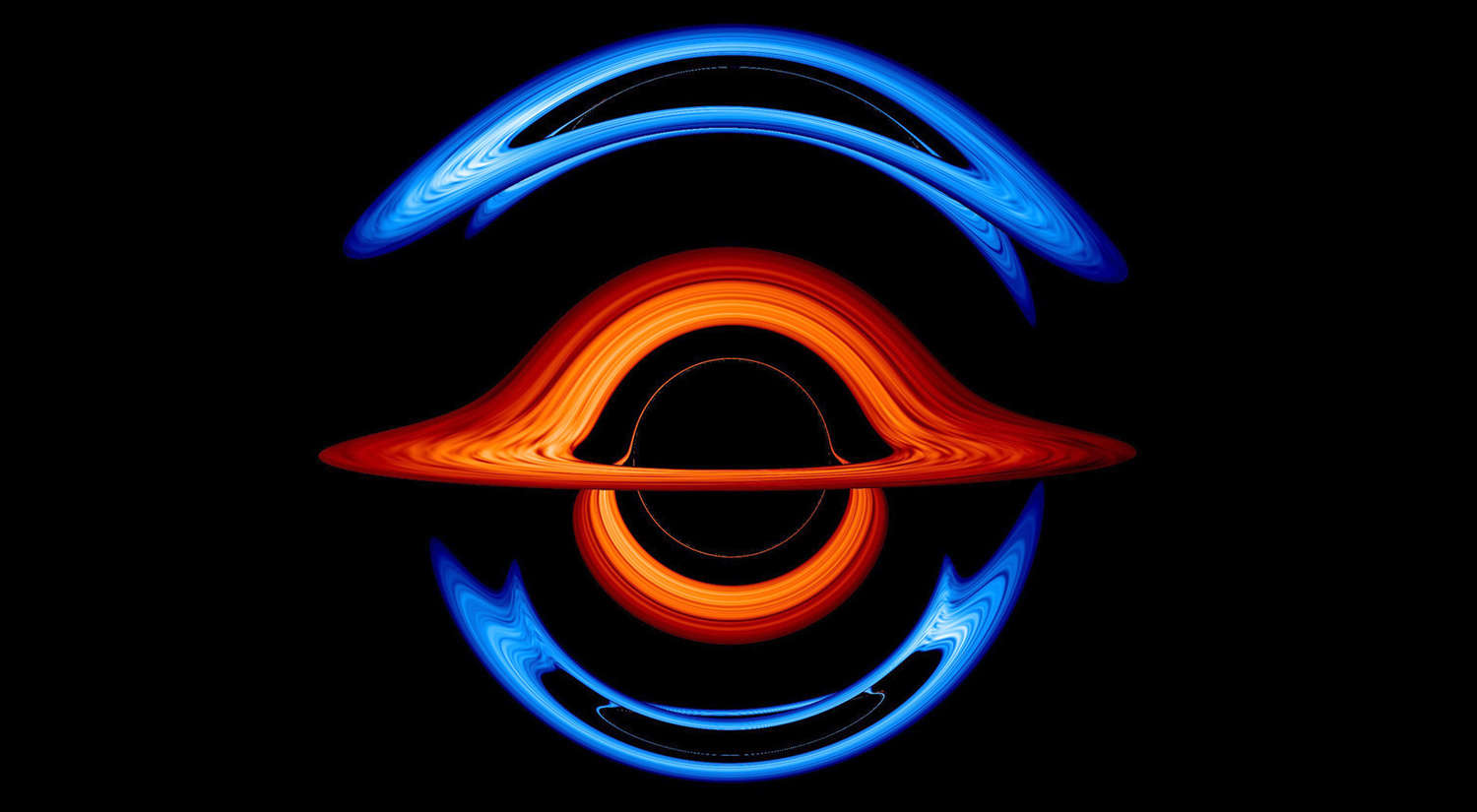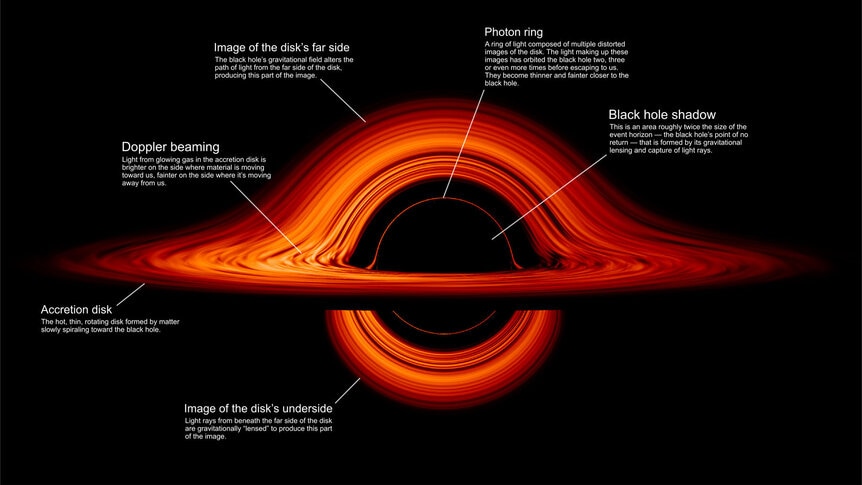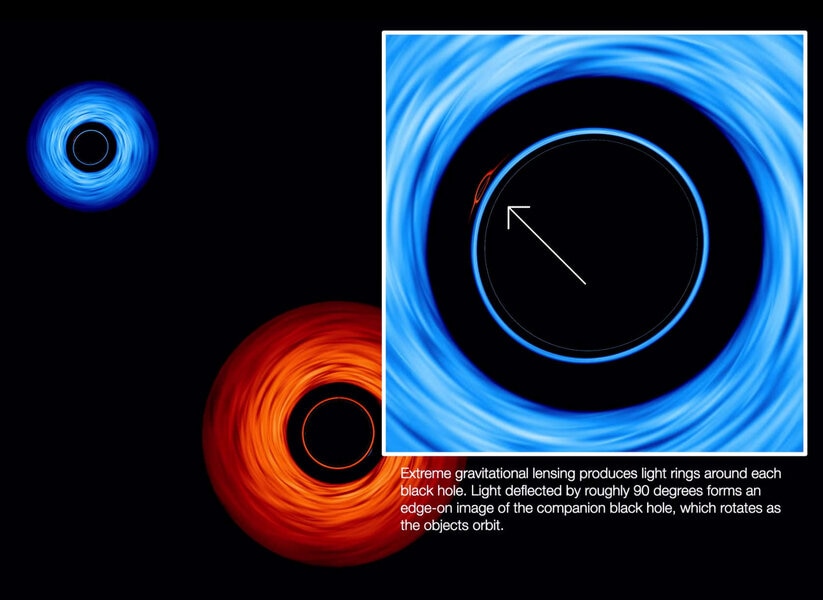Create a free profile to get unlimited access to exclusive videos, sweepstakes, and more!
Watch the doubly warped view of two monster black holes orbiting each other

Mostly, supermassive black holes like to live alone.
Sitting in the centers of all big galaxies, these monsters outweigh our Sun by a factor of millions, even billions. They chow down on stars, gas, dust, whatever unwary material gets too close.
Finding a second supermassive black hole close to the first one is rare. We've seen a few (and they should have been more common when the Universe was young), but they're not easy to spot.
Still, say they were… and say we could hop aboard the Enterprise and make the entirely questionable decision to warp on over to a binary supermassive black hole system. What would it look like?
Why, it would look like this:
This is not just CGI, it's a simulation based on solving the actual equations of the Theory Relativity, the laws that tell light how to behave in the presence of the immense gravity of black holes. Solving them for a single black hole is difficult — though it's been done before — but doing for two is far harder. Still, this is what it would look like if you were there.
In the simulation, one black hole is 200 million times the mass of the Sun (with the orange/red ring) and the other with 100 million solar masses (blue ring). Both are actively feeding on material falling into them. That matter forms a flat ring around them called an accretion disk.
Here's where things get funky. Briefly, 1) Black holes have intense gravity, and b) gravity warps space, and γ) light has to follow that distortion as it moves through space.
So, for example, the disk goes all the way around a black hole, like the rings do around Saturn. While the rings on the other side of Saturn from you are blocked from view by the planet itself, black holes warp space so severely that the light from the accretion disk on the other side gets bent all the way around the black hole, so you can actually see it above the black hole, like it's wearing a hat. Some of that light is also bent the other way, so you see the disk below the black hole as well.
There are also narrow rings of light as well, which come from the various weird ways photons can actually orbit a black hole before falling in (yes, light can orbit a black hole; if you were at the right spot near one you could look ahead of you and see the back of your own head). I have two articles describing this effect; one when the first (single black hole) video was released, and another about detailed calculations on how light works near a black hole.
Adding the second black hole introduces all kinds of bizarre effects. Not only is light from a black hole's disk distorted by its black hole, but it's also distorted by the other black hole. When the two black holes are nearly aligned to our view, the path the light takes is a cosmic Chutes and Ladders game, a funhouse mirror where it curves all around and winds up coming at you from a direction you don't expect.
The video starts with a face-on view, looking down on the pair with minimal distortion. Then it changes angles, and immediately the light from the lower mass black hole gets completely distorted by the bigger one, and vice-versa.
Not only is the image distorted, but there are multiple images of the black hole, too! As light is emitted by the disk around a black hole, some will pass over the second one and some under it, so we see two images of it.
As the video points out at the 1:17 mark, even when seen from above there is still distortion. Light from the big black hole gets bent around the smaller one, and we see an image of the bigger one close to the second one. And vice-versa; you can see an image of the small one near the big one (you might have to increase the resolution of the video to see them; it's available in 4k).
Another effect is subtle and bizarre. As they orbit, you see first one of the black holes approach you and then recede. As one heads toward you its size appears to shrink, and as it recedes it appears to get bigger. What the what?
The press release just mentions this as "relativistic aberration" but doesn't explain it. I tried to figure it out, but came up empty. So I sent a note to Jeremy Schnittman, the NASA astrophysicist who worked on the science of this simulation. When he replied I laughed — turns out I was overthinking it. This is a relatively simple effect, and one you're kinda already familiar with.
If you've ever been in a moving car when it rains, when you look out the front windshield it looks like the rain is slanted toward you, as if it's not falling straight down. That's because the speed of the car forward and the speed of the rain downward add as vectors, making it look like the rain is falling at angle toward you. The faster the car moves, the more that angle dips toward horizontal.
The same thing happens with light! The light we see from a moving object appears to come from a slightly different angle, and the faster the object moves the more the light appears to slant. This is called the aberration of light.
This effect is amplified in the video because the black holes are orbiting each other extremely rapidly. Relativity starts to play a role, which tends to focus the light in the direction the object is traveling. It appears to come from a bit closer to the black hole, which has the effect of making the black hole appear to shrink. When the black hole moves away the opposite effect happens: The light appears to come from a little farther from the black hole, so everything appears bigger.
It's subtle, and I don't know if I would've even noticed it if it weren't pointed out. But that goes to show you that there are a lot of surprising things going on near two black holes that orbit around each other at nearly the speed of light.
I think perhaps the least surprising thing about all this is all the surprising things. These are black holes, objects so dense with gravity so intense that they have in effect punched a hole in the fabric of spacetime. Of course weird stuff is going to happen.
















